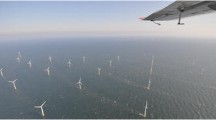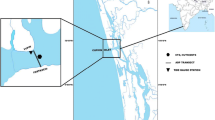Abstract
Purpose
A working group, composed of the University of Genoa (Italy), responsible for monitoring the dredging of the Port of Genoa, and Royal Boskalis Westminster N.V. (The Netherlands), responsible for the dredging activities, carried out an experiment on closing a landfill area with a double air bubble-screen (ABS) to verify the efficiency both of this method of containing sediment and of the measurement method applied.
Materials and methods
Within the Port of Genoa dredging, which was started in 2009, the dredged material is used to fill two areas between existing quays. To contain the sediment to be placed into a third subbasin without interrupting the passage of the barges which discharge the sediment, the use of an ABS was proposed as a barrier to the spreading of the sediment. The experiment was carried out during a 4-day oceanographic campaign to verify, preliminarily, the results under different weather and sea conditions. An artificial tracer, rhodamine water tracing (RWT), was used in varying concentrations to simulate the spreading of the sediment, and an RWT sensor and an acoustic Doppler current profiler (ADCP) were used to measure the RWT distribution and verify the efficiency of the ABS.
Results and discussion
The high turbidity in the port and the high rate of RWT dilution made it relatively difficult to detect the RWT. The RWT sensor sometimes measured higher values than expected probably due to the following: the recirculation of the tracer in current eddies, other sensible suspended matter and adsorption of RWT on suspended matter. The internal ABS could not retain all the RWT, possibly because it was much weaker than the external one, and because mitigating measures, like silt screens or ABSs, are not totally closed and should not be used if complete impermeability is required. The ABS introduction accentuated the natural separation between the basin and the channel water bodies creating a barrier between the two basins.
Conclusions
An ABS installed at the entrance to a confined area with low dynamics results in a circular vertical flow with the potential to retain suspended sediments within an enclosed area. The meteorological variability during the tests showed that a weak ABS could malfunction in the presence of strong wind condition. The results showed that the ADCP is a suitable instrument to highlight the ABS position and its effect on the surrounding hydrodynamics. Further research, using a sediment tracer, is required to study with greater detail the effects of the ABS on the water column.











Similar content being viewed by others
References
Bray RN (2008) Environmental aspects of dredging. Taylor and Francis, London
Capello M, Cutroneo L, Castellano M, Orsi M, Pieracci A, Bertolotto RM, Povero P, Tucci S (2010) Physical and sedimentological characterisation of dredged sediments. Chem Ecol 26:359–369
Cederwall K, Ditmars JD (1970) Analysis of air-bubble plumes. W. M. Keck Laboratory of Hydraulics and Water Resources, Division of Engineering and Applied Science, California Institute of Technology, Pasadena, California, USA. http://authors.library.caltech.edu/25998/1/KH-R-24.pdf
Cutroneo L, Castellano M, Pieracci A, Povero P, Tucci S, Capello M (2012) The use of a combined monitoring system for following a turbid plume generated by dredging activities in a port. J Soils Sediments 12:797–809
Cutroneo L, Castellano M, Ferranti MP, Povero P, Tucci S, Capello M (2013) Optical and acoustic instruments to study the turbid plumes generated by three different types of dredges during dredging inside and outside a port. J Soils Sediments 13:1645–1654
De Nekker J, Knol J (1968) Results of experiments with an airbubble screen against siltation in the Rotterdam Harbour. In: Vlaamse Ingenieursvereniging (ed) International Harbour Conference, 5th, Antwerp, papers and proceedings. Antwerp, Belgium, pp 187
Dugué V, Blanckaert K, Schleiss AJ (2012) An air-bubble screen used as a countermeasure to reduce erosion in open-canal bends. ICSE6 Paris, 27(31):519–526. http://infoscience.epfl.ch/record/181418/files/2012-876_Dugue_Blanckaert_Schleiss_An_Air_bubble_Screen.pdf
Francingues NR, Palermo MR (2005) Silt curtains as a dredging project management practice. DOER Technical Notes Collection (ERDC TN-DOER-E21). U.S. Army Engineer Research and Development Center, Vicksburg, Mississippi, USA. http://el.erdc.usace.army.mil/dots/doer/doer.html
Headland J, Kirby R, Winterwerp H, Nasner H, Vested J, Sas M, Lamers K, Nakagawa Y, Enriquez J, Westermeier F, Paul J (2007) Minimizing Harbor Siltation (MHS). Ports 2007: 30 Years of Sharing Ideas: 1997–2007, American Society of Civil Engineers, New York, NY, pp 1–10. doi: 10.1061/40834(238)28
Kobus H (1968) Analysis of the flow induced by air-bubble systems. Proc 11th Conf Coast Eng Lond 2:1016–1031
Laane RWPM, Manuels MW, Staal W (1984) A procedure for enriching and cleaning up rhodamine B and rhodamine WT in natural waters, using a sep-pak C18 Cartridge. Water Res 18:163–165
Maruyama S, Tsubaki K, Taira K, Sakai S (2004) Artificial upwelling of deep seawater using the perpetual salt fountain for cultivation of ocean desert. J Oceanogr 60:563–568
MassDep (2012) Navigational Dredging Work Protocols. http://www.epa.gov/region1/superfund/sites/newbedford/507226.pdf
Mines CH, Ghadouani A, Ivey GN (2009) Dying to find the source—the quantitative use of rhodamine WT as a proxy for soluble point source pollutants in closed pipe surface drainage networks. Hydrol Earth Syst Sci 6:4535–4562
Nakai M, Arita M (2002) An experimental study on prevention of saline wedge intrusion by an air curtain in rivers. J Hydraul Res 40:333–339
OSPAR (2004) Environmental impacts to marine species and habitats of dredging for navigational purposes. OSPAR Commission, Biological diversity and ecosystems series, no. 208, pp 22. ISBN 1-904426-48-4. http://www.ospar.org/documents/dbase/publications/p00208/p00208_environmental impacts to marine species.pdf
Pang LP, Goltz M, Close M (2003) Application of the method of temporal moments to interpret solute transport with sorption and degradation. J Contam Hydrol 60:123–134
PIANC (2009) Dredging Management Practices for the Environment: A structured selection approach. PIANC Report no. 100, Brussels, Belgium, pp 184
Pitt R (2002) Emerging stormwater controls for critical sources areas. In: Field R, Sullivan D (eds) Management of wet-weather flow in the watershed. CRC Press, Boca Raton, pp 103–140
Radermacher M, Van der Goot F, Rijks DC, de Wit L (2013) The art of screening: effectiveness of silt screens. Terra et Aqua 132:3–12
Rao AMF, McCarthy MJ, Gardner WS, Jahnke RA (2007) Respiration and denitrification in permeable continental shelf deposits on the South Atlantic Bight: rates of carbon and nitrogen cycling from sediment column experiments. Cont Shelf Res 27:1801–1819
Richardson SD, Willson CS, Rusch KA (2004) Use of rhodamine water tracer in the marshland upwelling system. Ground Water 42:678–688
Rijkswaterstaat Directie Oost-Nederland (2000) Voorkomen van sedimentatie in havens verkennen van maatregelen. Limburg, Zuid-Holland, IJsselmeergebied, Nederland (in Dutch)
Sabatini DA, Austin TA (1991) Characteristics of Rhodamine WT and fluorescein as adsorbing ground-water tracers. Ground Water 29:341–349
Sabol B, Shafer D, Lord E (2005) Dredging effects on eelgrass (Zostera marina) distribution in a New England small boat harbor. US Army Corps of Engineers, Engineer Research and Development Center, Environmental Laboratory, Technical Report ERDC/EL TR-05-8, Vicksburg, 31 pp
Schladow SG (1993) Lake destratification by bubble-plume systems—design methodology. J Hydraul Eng ASCE 119:350–368
Stacey MT, Cowen EA, Powell TM, Dobbins E, Monismith SG, Koseff JR (2000) Plume dispersion in a stratified, near-coastal flow: measurements and modeling. Cont Shelf Res 20:637–663
Suedel BC, Lutz CH, Clarke JU, Clarke DG (2012) The effects of suspended sediment on walleye (Sander vitreus) eggs. J Soils Sediments 12:995–1003
Tsubaki K, Maruyama S, Komiya A, Mitsugashira H (2007) Continuous measurement of an artificial upwelling of deep sea water induced by the perpetual salt fountain. Deep-Sea Res I 54:75–84
Turner (1973) Buoyancy effects in fluids. Cambridge University Press, Cambridge
Uijttewaal WSJ, Oliemans RVA (1996) Particle dispersion and deposition in direct numerical and large eddy simulations of vertical pipe flows. Phys Fluids 8:2590–2604
Vasudevan D, Fimmen RL, Francisco AB (2001) Tracer-grade rhodamine WT: structure of constituent isomers and their sorption behaviour. Environ Sci Technol 35:4089–4096
Zhang Q, Volker RE, Lockington DA (2002) Experimental investigation of contaminant transport in coastal groundwater. Adv Environ Res 6:229–237
Acknowledgments
The authors wish to thank Professor Paul K. Nixon for the English revision of the manuscript, Officers and Crews of the M/V Maso and the Tug Halli for their assistance during the experiment, and all the colleagues involved in this work. We also thank Professor Wim Uijttewaal, TU Delft, for the clarification of the turbid fluid. We are particular grateful for the many helpful suggestions provided by the reviewers of this manuscript. This study was funded by the Research Fund of the Port Authority of Genoa.
Author information
Authors and Affiliations
Corresponding author
Additional information
Responsible editor: Trudy J. Estes
Rights and permissions
About this article
Cite this article
Cutroneo, L., van der Goot, F., Roels, A. et al. A check on the efficiency of an air-bubble screen using acoustic measurements and an artificial tracer. J Soils Sediments 14, 1626–1637 (2014). https://doi.org/10.1007/s11368-014-0915-3
Received:
Accepted:
Published:
Issue Date:
DOI: https://doi.org/10.1007/s11368-014-0915-3




